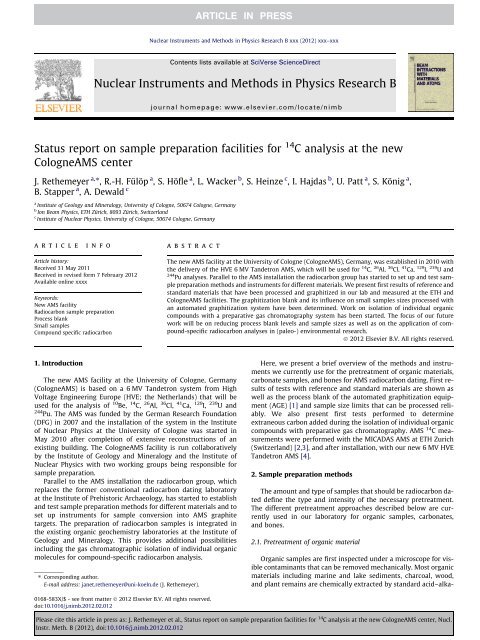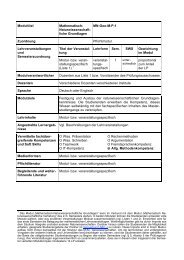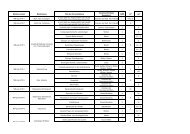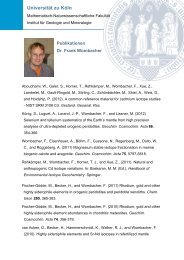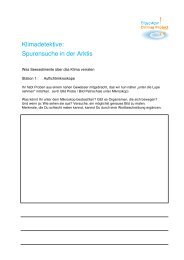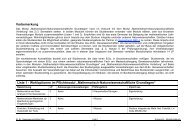Status report on sample preparation facilities for 14C analysis at the ...
Status report on sample preparation facilities for 14C analysis at the ...
Status report on sample preparation facilities for 14C analysis at the ...
Create successful ePaper yourself
Turn your PDF publications into a flip-book with our unique Google optimized e-Paper software.
Nuclear Instruments and Methods in Physics Research B xxx (2012) xxx–xxx<br />
C<strong>on</strong>tents lists available <strong>at</strong> SciVerse ScienceDirect<br />
Nuclear Instruments and Methods in Physics Research B<br />
journal homepage: www.elsevier.com/loc<strong>at</strong>e/nimb<br />
<str<strong>on</strong>g>St<strong>at</strong>us</str<strong>on</strong>g> <str<strong>on</strong>g>report</str<strong>on</strong>g> <strong>on</strong> <strong>sample</strong> prepar<strong>at</strong>i<strong>on</strong> <strong>facilities</strong> <strong>for</strong> 14 C <strong>analysis</strong> <strong>at</strong> <strong>the</strong> new<br />
CologneAMS center<br />
J. Re<strong>the</strong>meyer a,⇑ , R.-H. Fülöp a , S. Höfle a , L. Wacker b , S. Heinze c , I. Hajdas b , U. P<strong>at</strong>t a , S. König a ,<br />
B. Stapper a , A. Dewald c<br />
a Institute of Geology and Mineralogy, University of Cologne, 50674 Cologne, Germany<br />
b I<strong>on</strong> Beam Physics, ETH Zürich, 8093 Zürich, Switzerland<br />
c Institute of Nuclear Physics, University of Cologne, 50674 Cologne, Germany<br />
article<br />
info<br />
abstract<br />
Article history:<br />
Received 31 May 2011<br />
Received in revised <strong>for</strong>m 7 February 2012<br />
Available <strong>on</strong>line xxxx<br />
Keywords:<br />
New AMS facility<br />
Radiocarb<strong>on</strong> <strong>sample</strong> prepar<strong>at</strong>i<strong>on</strong><br />
Process blank<br />
Small <strong>sample</strong>s<br />
Compound specific radiocarb<strong>on</strong><br />
The new AMS facility <strong>at</strong> <strong>the</strong> University of Cologne (CologneAMS), Germany, was established in 2010 with<br />
<strong>the</strong> delivery of <strong>the</strong> HVE 6 MV Tandetr<strong>on</strong> AMS, which will be used <strong>for</strong> 14 C, 26 Al, 36 Cl, 41 Ca, 129 I, 239 U and<br />
244 Pu analyses. Parallel to <strong>the</strong> AMS install<strong>at</strong>i<strong>on</strong> <strong>the</strong> radiocarb<strong>on</strong> group has started to set up and test <strong>sample</strong><br />
prepar<strong>at</strong>i<strong>on</strong> methods and instruments <strong>for</strong> different m<strong>at</strong>erials. We present first results of reference and<br />
standard m<strong>at</strong>erials th<strong>at</strong> have been processed and graphitized in our lab and measured <strong>at</strong> <strong>the</strong> ETH and<br />
CologneAMS <strong>facilities</strong>. The graphitiz<strong>at</strong>i<strong>on</strong> blank and its influence <strong>on</strong> small <strong>sample</strong>s sizes processed with<br />
an autom<strong>at</strong>ed graphitiz<strong>at</strong>i<strong>on</strong> system have been determined. Work <strong>on</strong> isol<strong>at</strong>i<strong>on</strong> of individual organic<br />
compounds with a prepar<strong>at</strong>ive gas chrom<strong>at</strong>ography system has been started. The focus of our future<br />
work will be <strong>on</strong> reducing process blank levels and <strong>sample</strong> sizes as well as <strong>on</strong> <strong>the</strong> applic<strong>at</strong>i<strong>on</strong> of compound-specific<br />
radiocarb<strong>on</strong> analyses in (paleo-) envir<strong>on</strong>mental research.<br />
Ó 2012 Elsevier B.V. All rights reserved.<br />
1. Introducti<strong>on</strong><br />
The new AMS facility <strong>at</strong> <strong>the</strong> University of Cologne, Germany<br />
(CologneAMS) is based <strong>on</strong> a 6 MV Tandetr<strong>on</strong> system from High<br />
Voltage Engineering Europe (HVE; <strong>the</strong> Ne<strong>the</strong>rlands) th<strong>at</strong> will be<br />
used <strong>for</strong> <strong>the</strong> <strong>analysis</strong> of 10 Be, 14 C, 26 Al, 36 Cl,<br />
41 Ca, 129 I,<br />
239 U and<br />
244 Pu. The AMS was funded by <strong>the</strong> German Research Found<strong>at</strong>i<strong>on</strong><br />
(DFG) in 2007 and <strong>the</strong> install<strong>at</strong>i<strong>on</strong> of <strong>the</strong> system in <strong>the</strong> Institute<br />
of Nuclear Physics <strong>at</strong> <strong>the</strong> University of Cologne was started in<br />
May 2010 after completi<strong>on</strong> of extensive rec<strong>on</strong>structi<strong>on</strong>s of an<br />
existing building. The CologneAMS facility is run collabor<strong>at</strong>ively<br />
by <strong>the</strong> Institute of Geology and Mineralogy and <strong>the</strong> Institute of<br />
Nuclear Physics with two working groups being resp<strong>on</strong>sible <strong>for</strong><br />
<strong>sample</strong> prepar<strong>at</strong>i<strong>on</strong>.<br />
Parallel to <strong>the</strong> AMS install<strong>at</strong>i<strong>on</strong> <strong>the</strong> radiocarb<strong>on</strong> group, which<br />
replaces <strong>the</strong> <strong>for</strong>mer c<strong>on</strong>venti<strong>on</strong>al radiocarb<strong>on</strong> d<strong>at</strong>ing labor<strong>at</strong>ory<br />
<strong>at</strong> <strong>the</strong> Institute of Prehistoric Archaeology, has started to establish<br />
and test <strong>sample</strong> prepar<strong>at</strong>i<strong>on</strong> methods <strong>for</strong> different m<strong>at</strong>erials and to<br />
set up instruments <strong>for</strong> <strong>sample</strong> c<strong>on</strong>versi<strong>on</strong> into AMS graphite<br />
targets. The prepar<strong>at</strong>i<strong>on</strong> of radiocarb<strong>on</strong> <strong>sample</strong>s is integr<strong>at</strong>ed in<br />
<strong>the</strong> existing organic geochemistry labor<strong>at</strong>ories <strong>at</strong> <strong>the</strong> Institute of<br />
Geology and Mineralogy. This provides additi<strong>on</strong>al possibilities<br />
including <strong>the</strong> gas chrom<strong>at</strong>ographic isol<strong>at</strong>i<strong>on</strong> of individual organic<br />
molecules <strong>for</strong> compound-specific radiocarb<strong>on</strong> <strong>analysis</strong>.<br />
⇑ Corresp<strong>on</strong>ding author.<br />
E-mail address: janet.re<strong>the</strong>meyer@uni-koeln.de (J. Re<strong>the</strong>meyer).<br />
Here, we present a brief overview of <strong>the</strong> methods and instruments<br />
we currently use <strong>for</strong> <strong>the</strong> pretre<strong>at</strong>ment of organic m<strong>at</strong>erials,<br />
carb<strong>on</strong><strong>at</strong>e <strong>sample</strong>s, and b<strong>on</strong>es <strong>for</strong> AMS radiocarb<strong>on</strong> d<strong>at</strong>ing. First results<br />
of tests with reference and standard m<strong>at</strong>erials are shown as<br />
well as <strong>the</strong> process blank of <strong>the</strong> autom<strong>at</strong>ed graphitiz<strong>at</strong>i<strong>on</strong> equipment<br />
(AGE) [1] and <strong>sample</strong> size limits th<strong>at</strong> can be processed reliably.<br />
We also present first tests per<strong>for</strong>med to determine<br />
extraneous carb<strong>on</strong> added during <strong>the</strong> isol<strong>at</strong>i<strong>on</strong> of individual organic<br />
compounds with prepar<strong>at</strong>ive gas chrom<strong>at</strong>ography. AMS 14 C measurements<br />
were per<strong>for</strong>med with <strong>the</strong> MICADAS AMS <strong>at</strong> ETH Zurich<br />
(Switzerland) [2,3], and after install<strong>at</strong>i<strong>on</strong>, with our new 6 MV HVE<br />
Tandetr<strong>on</strong> AMS [4].<br />
2. Sample prepar<strong>at</strong>i<strong>on</strong> methods<br />
The amount and type of <strong>sample</strong>s th<strong>at</strong> should be radiocarb<strong>on</strong> d<strong>at</strong>ed<br />
define <strong>the</strong> type and intensity of <strong>the</strong> necessary pretre<strong>at</strong>ment.<br />
The different pretre<strong>at</strong>ment approaches described below are currently<br />
used in our labor<strong>at</strong>ory <strong>for</strong> organic <strong>sample</strong>s, carb<strong>on</strong><strong>at</strong>es,<br />
and b<strong>on</strong>es.<br />
2.1. Pretre<strong>at</strong>ment of organic m<strong>at</strong>erial<br />
Organic <strong>sample</strong>s are first inspected under a microscope <strong>for</strong> visible<br />
c<strong>on</strong>taminants th<strong>at</strong> can be removed mechanically. Most organic<br />
m<strong>at</strong>erials including marine and lake sediments, charcoal, wood,<br />
and plant remains are chemically extracted by standard acid–alka-<br />
0168-583X/$ - see fr<strong>on</strong>t m<strong>at</strong>ter Ó 2012 Elsevier B.V. All rights reserved.<br />
doi:10.1016/j.nimb.2012.02.012<br />
Please cite this article in press as: J. Re<strong>the</strong>meyer et al., <str<strong>on</strong>g>St<strong>at</strong>us</str<strong>on</strong>g> <str<strong>on</strong>g>report</str<strong>on</strong>g> <strong>on</strong> <strong>sample</strong> prepar<strong>at</strong>i<strong>on</strong> <strong>facilities</strong> <strong>for</strong> 14 C <strong>analysis</strong> <strong>at</strong> <strong>the</strong> new CologneAMS center, Nucl.<br />
Instr. Meth. B (2012), doi:10.1016/j.nimb.2012.02.012
2 J. Re<strong>the</strong>meyer et al. / Nuclear Instruments and Methods in Physics Research B xxx (2012) xxx–xxx<br />
li–acid extracti<strong>on</strong> (AAA) to remove inorganic carb<strong>on</strong> and humic<br />
substances, which may have been transported from o<strong>the</strong>r depth<br />
intervals in <strong>the</strong> soil or sediment layers th<strong>at</strong> should be d<strong>at</strong>ed [5].<br />
The AAA procedure starts with an acid extracti<strong>on</strong> of <strong>the</strong> <strong>sample</strong><br />
(1% HCl, ca. 10 h, room temp.; carb<strong>on</strong><strong>at</strong>e-rich <strong>sample</strong>s are he<strong>at</strong>ed<br />
ca. 1 h, 60 °C) followed by washing of <strong>the</strong> residue repe<strong>at</strong>edly with<br />
Milli-Q w<strong>at</strong>er (Millipore, USA). For very small <strong>sample</strong>s <strong>the</strong> extracti<strong>on</strong><br />
time is reduced (1 h, room temp.) and no alkali extracti<strong>on</strong> is<br />
applied. The alkali extracti<strong>on</strong> with 1% NaOH (4 h, 60 °C) yields an<br />
alkali-soluble fracti<strong>on</strong> and a n<strong>on</strong>-soluble residue (humin). Humic<br />
acids are precipit<strong>at</strong>ed from <strong>the</strong> soluble fracti<strong>on</strong> by acidific<strong>at</strong>i<strong>on</strong><br />
with 37% HCl to pH < 1 followed by rinsing <strong>the</strong> precipit<strong>at</strong>e with<br />
Milli-Q w<strong>at</strong>er to a pH of about 2. The acid and alkali insoluble residue,<br />
<strong>the</strong> humin fracti<strong>on</strong>, is also washed repe<strong>at</strong>edly with Milli-Q<br />
w<strong>at</strong>er and tre<strong>at</strong>ed again with 1% HCl (ca. 10 h, room temp.) to remove<br />
<strong>at</strong>mospheric CO 2 which might have been introduced during<br />
<strong>the</strong> alkali extracti<strong>on</strong>, and finally rinsed with Milli-Q w<strong>at</strong>er to<br />
pH > 4.<br />
2.2. B<strong>on</strong>e pretre<strong>at</strong>ment<br />
A discussi<strong>on</strong> of <strong>the</strong> various problems associ<strong>at</strong>ed with b<strong>on</strong>e pretre<strong>at</strong>ment<br />
can be found in [6,7]. We have tested <strong>the</strong> following approach<br />
<strong>for</strong> cleaning of b<strong>on</strong>es and extracti<strong>on</strong> of <strong>the</strong> collagen<br />
fracti<strong>on</strong>: a 3–5 g b<strong>on</strong>e sub<strong>sample</strong> is cut from <strong>the</strong> original <strong>sample</strong>.<br />
The surface of <strong>the</strong> sub<strong>sample</strong> is abraded with a diam<strong>on</strong>d drill<br />
and cleaned twice with Milli-Q w<strong>at</strong>er in an ultras<strong>on</strong>ic b<strong>at</strong>h<br />
(15 min). After drying, <strong>the</strong> <strong>sample</strong> is inspected under a microscope<br />
<strong>for</strong> any c<strong>on</strong>tamin<strong>at</strong>i<strong>on</strong> th<strong>at</strong> might have been introduced during<br />
handling and <strong>the</strong>n crushed into small pieces. If necessary, organic<br />
c<strong>on</strong>taminants including c<strong>on</strong>serv<strong>at</strong>i<strong>on</strong> products are removed with<br />
a sequence of organic solvents of increasing polarity starting with<br />
hexane, followed by dichloromethane, and methanol (12 h each;<br />
modified after [8]). Large <strong>sample</strong>s are extracted in glass fiber thimble<br />
in a Soxhlet extractor and small <strong>sample</strong>s in an Acceler<strong>at</strong>ed Solvent<br />
Extracti<strong>on</strong> system <strong>at</strong> 120 °C and 75 bar (ASE 200; Di<strong>on</strong>ex,<br />
USA) using <strong>the</strong> same sequence of organic solvents as above and<br />
an extracti<strong>on</strong> time of 30 min <strong>for</strong> each solvent.<br />
The dried <strong>sample</strong>s are decalcified with 1 M HCl (<strong>at</strong> least 3 h,<br />
room temp.). The <strong>sample</strong>s are fur<strong>the</strong>r cleaned from insoluble c<strong>on</strong>taminants<br />
and humic substances by adding Milli-Q w<strong>at</strong>er and<br />
<strong>the</strong>reby increasing <strong>the</strong> pH to about 3 while <strong>the</strong> <strong>sample</strong> is placed<br />
in <strong>the</strong> agit<strong>at</strong>ing w<strong>at</strong>er b<strong>at</strong>h (24 h, 60 °C). After cleaning <strong>the</strong> <strong>sample</strong>s<br />
are c<strong>on</strong>verted into gel<strong>at</strong>in, [9,10] which is subjected to hot filtr<strong>at</strong>i<strong>on</strong><br />
(60 °C) through glass fiber filters. If necessary <strong>the</strong> volume of<br />
<strong>the</strong> filtr<strong>at</strong>e is reduced under a N 2 stream while he<strong>at</strong>ed <strong>at</strong> 40 °C,<br />
and finally <strong>the</strong> gel<strong>at</strong>in is freeze-dried and c<strong>on</strong>verted to graphite<br />
as described below (Secti<strong>on</strong> 2.5).<br />
2.3. Carb<strong>on</strong><strong>at</strong>e pretre<strong>at</strong>ment and hydrolysis<br />
We use a newly developed hydrolysis system described in detail<br />
by Wacker et al. [11] in which carb<strong>on</strong><strong>at</strong>es are c<strong>on</strong>verted into CO 2<br />
with H 3 PO 4 in septum sealed vials under a He <strong>at</strong>mosphere. This<br />
system elimin<strong>at</strong>es <strong>the</strong> usage of liquid nitrogen and self-made high<br />
vacuum systems <strong>for</strong> gas purific<strong>at</strong>i<strong>on</strong> after carb<strong>on</strong><strong>at</strong>e hydrolysis in<br />
evacu<strong>at</strong>ed glass tubes as it is often d<strong>on</strong>e. A fur<strong>the</strong>r advantage is<br />
th<strong>at</strong> <strong>the</strong> hydrolysis procedure can be autom<strong>at</strong>ed by using an<br />
auto-<strong>sample</strong>r, which can be coupled with <strong>the</strong> AGE system.<br />
Briefly, visible c<strong>on</strong>tamin<strong>at</strong>i<strong>on</strong>s <strong>on</strong> <strong>the</strong> carb<strong>on</strong><strong>at</strong>e surface are<br />
mechanical removed, followed by washing with Milli-Q w<strong>at</strong>er in<br />
an ultras<strong>on</strong>ic b<strong>at</strong>h to remove soil remains and recrystallized shell<br />
m<strong>at</strong>erial [12]. The surface of <strong>the</strong> shell is <strong>the</strong>n leached with 1 M<br />
H 2 SO 4 , which is neutralized with Milli-Q w<strong>at</strong>er. After drying, <strong>the</strong><br />
<strong>sample</strong> is pulverized and transferred to cleaned (dichloromethane<br />
rinsed, combusti<strong>on</strong> <strong>at</strong> 450 °C) 12 ml Labco Ò vials (Labco Limited,<br />
UK), which are closed with septum caps. After air is removed from<br />
<strong>the</strong> vial with a He flow through a double-walled needle (Thermo,<br />
Germany) <strong>at</strong> a r<strong>at</strong>e of 100 ml/min <strong>for</strong> 12 min, 99% H 3 PO 4 is added<br />
and left to react <strong>for</strong> 6 h <strong>at</strong> 75 °C. The evolved CO 2 is transferred<br />
with a He flow to <strong>the</strong> AGE system while w<strong>at</strong>er is retained <strong>on</strong> a<br />
w<strong>at</strong>er trap (phosphorus pentoxide).<br />
2.4. Isol<strong>at</strong>i<strong>on</strong> of individual organic compounds<br />
Compound-specific radiocarb<strong>on</strong> <strong>analysis</strong> involves <strong>the</strong> extracti<strong>on</strong><br />
of <strong>the</strong> desired fracti<strong>on</strong> (often lipids) from <strong>the</strong> <strong>sample</strong> m<strong>at</strong>erial, followed<br />
by different purific<strong>at</strong>i<strong>on</strong> procedures like chrom<strong>at</strong>ographic<br />
separ<strong>at</strong>i<strong>on</strong> of compound classes of different polarities and often<br />
<strong>the</strong> isol<strong>at</strong>i<strong>on</strong> of individual molecules with prepar<strong>at</strong>ive gas or liquid<br />
chrom<strong>at</strong>ography [13,14]. Each step of <strong>the</strong> complex procedure may<br />
introduce c<strong>on</strong>taminants.<br />
We per<strong>for</strong>med first tests with d<strong>at</strong>ed GC standards to quantify<br />
<strong>the</strong> amount and origin of extraneous carb<strong>on</strong> introduced during<br />
<strong>the</strong> gas chrom<strong>at</strong>ographic isol<strong>at</strong>i<strong>on</strong> of individual organic compounds.<br />
The prepar<strong>at</strong>ive gas chrom<strong>at</strong>ograph (PC-GC) c<strong>on</strong>sists of a<br />
GC (7680 Agilent, USA) equipped with a CIS 4 injecti<strong>on</strong> system<br />
(Gerstel, Germany) and a ‘megabore’ ultra-low bleed capillary column<br />
(30 m, 0.53 mm I.D.; Restek, USA), which is coupled with a<br />
fracti<strong>on</strong> collector (PFC; Gerstel, Germany). Two n-alkanes and<br />
two n-carboxylic acids GC standards with modern and (close to)<br />
fossil 14 C c<strong>on</strong>centr<strong>at</strong>i<strong>on</strong> were chosen in order to m<strong>on</strong>itor possible<br />
modern or fossil carb<strong>on</strong> c<strong>on</strong>tributi<strong>on</strong>s (Table 1). The standards<br />
were dissolved in dichloromethane or hexane and repe<strong>at</strong>edly injected<br />
(50–100) in <strong>the</strong> PC-GC system. The column temper<strong>at</strong>ure<br />
<strong>for</strong> n-alkanes and <strong>for</strong> n-f<strong>at</strong>ty acids was increased from 70 to<br />
150 °C <strong>at</strong>20°C min 1 and <strong>the</strong>n to 320 °C <strong>at</strong>10°C min 1 and maintained<br />
<strong>for</strong> 9 min. The PFC transfer line was he<strong>at</strong>ed c<strong>on</strong>stantly <strong>at</strong><br />
320 °C. L<strong>on</strong>g-chain compounds (>C 24 ) were first trapped <strong>at</strong> 60 °C<br />
but compound recoveries could be increased by leaving <strong>the</strong> traps<br />
of <strong>the</strong> fracti<strong>on</strong> collector <strong>at</strong> room temper<strong>at</strong>ure <strong>for</strong> short and l<strong>on</strong>g<br />
chain compounds. The isol<strong>at</strong>ed compounds were recovered from<br />
<strong>the</strong> glass traps of <strong>the</strong> PFC with 1000 ll dichloromethane and measured<br />
<strong>on</strong> a GC with flame i<strong>on</strong>iz<strong>at</strong>i<strong>on</strong> detector (FID) to check purity<br />
and recovery of <strong>the</strong> isol<strong>at</strong>ed compound. After solvent evapor<strong>at</strong>i<strong>on</strong><br />
under N 2 stream, some compounds were c<strong>on</strong>verted to graphite<br />
with <strong>the</strong> AGE system as described below (Secti<strong>on</strong> 2.5). Because of<br />
<strong>the</strong> str<strong>on</strong>ger influence of <strong>the</strong> EA-AGE blank (Secti<strong>on</strong> 3.1) <strong>on</strong> small<br />
<strong>sample</strong>s sizes typically isol<strong>at</strong>ed with PC-GC, most isol<strong>at</strong>ed<br />
compounds (30–140 lg C) were combusted in quartz tubes<br />
Table 1<br />
First results of recovery and c<strong>on</strong>tamin<strong>at</strong>i<strong>on</strong> tests of <strong>the</strong> PC-GC system with d<strong>at</strong>ed GC<br />
standards (n-carboxylic acids, n-alkanes). Carboxylic acids were isol<strong>at</strong>ed as methyl<br />
esters and 14 C results were corrected <strong>for</strong> <strong>the</strong> methyl carb<strong>on</strong> from methanol (0 pmC).<br />
Samples were c<strong>on</strong>verted to graphite with <strong>the</strong> AGE system or by sealed tube<br />
combusti<strong>on</strong> to CO 2 and measured directly with <strong>the</strong> MICADAS gas i<strong>on</strong> source [15,16].<br />
14 C values are corrected <strong>for</strong> combusti<strong>on</strong> and graphitiz<strong>at</strong>i<strong>on</strong> blank.<br />
GC standard Tre<strong>at</strong>ment n Recovery f (%)<br />
14 C (pmC)<br />
Octadecanoic acid a Untre<strong>at</strong>ed 1 106.38 ± 0.15<br />
PC-GC e 3 99 101.95 ± 1.62<br />
Triac<strong>on</strong>tanoic acid b Untre<strong>at</strong>ed 1 0.25 ± 0.07<br />
PC-GC e 4 86 3.63 ± 1.41<br />
Octadecane c Untre<strong>at</strong>ed 1
J. Re<strong>the</strong>meyer et al. / Nuclear Instruments and Methods in Physics Research B xxx (2012) xxx–xxx 3<br />
(900 °C, 4 h) with copper oxide (ca. 60 mg), both pre-combusted,<br />
and <strong>the</strong> purified CO 2 was measured directly with <strong>the</strong> MICADAS<br />
gas i<strong>on</strong> source [15,16].<br />
2.5. Sample combusti<strong>on</strong>, hydrolysis and graphitiz<strong>at</strong>i<strong>on</strong><br />
We use an advanced versi<strong>on</strong> of <strong>the</strong> AGE system [1] coupled with<br />
an elemental analyzer (EA; VarioMicroCube, Elementar, Germany)<br />
<strong>for</strong> <strong>the</strong> combusti<strong>on</strong> and graphitiz<strong>at</strong>i<strong>on</strong> of organic <strong>sample</strong>s. The EA is<br />
equipped with a combusti<strong>on</strong> tube filled with PbCrO 4 and copper<br />
oxide and a reducti<strong>on</strong> tube with copper and silver wool. Depending<br />
<strong>on</strong> <strong>sample</strong> size, pretre<strong>at</strong>ed organic <strong>sample</strong>s are weighed into tin<br />
bo<strong>at</strong>s (H W D: 4 4 11 mm, IVA, Germany) and combusted<br />
in <strong>the</strong> EA. W<strong>at</strong>er evolved during <strong>sample</strong> combusti<strong>on</strong> is retained<br />
<strong>on</strong> a w<strong>at</strong>er trap (phosphorus pentoxide) in <strong>the</strong> EA and <strong>the</strong> pure<br />
CO 2 is transferred to <strong>the</strong> zeolite trap of <strong>the</strong> AGE. The CO 2 is <strong>the</strong>rmally<br />
desorbed from <strong>the</strong> zeolite trap and released into a reactor<br />
of <strong>the</strong> AGE where it is c<strong>on</strong>verted to graphite with hydrogen over<br />
ir<strong>on</strong> as c<strong>at</strong>alyst (Alfa-Aesar, ir<strong>on</strong> powder, spherical, 48,500 ± 800 years BP). A c<strong>on</strong>stant c<strong>on</strong>tamin<strong>at</strong>i<strong>on</strong> similar to <strong>the</strong><br />
<strong>on</strong>e of <strong>the</strong> combusti<strong>on</strong> in <strong>the</strong> EA is not observed suggesting th<strong>at</strong><br />
<strong>the</strong> carb<strong>on</strong> c<strong>on</strong>tamin<strong>at</strong>i<strong>on</strong> observed <strong>for</strong> organic <strong>sample</strong>s is introduced<br />
during <strong>sample</strong> combusti<strong>on</strong> in <strong>the</strong> EA.<br />
3.2. PC-GC blank<br />
Uncleaned bo<strong>at</strong>s (COL1001)<br />
Cleaned bo<strong>at</strong>s (COL1001)<br />
Cleaned bo<strong>at</strong>s (COL1000)<br />
C<strong>on</strong>stant c<strong>on</strong>tamin<strong>at</strong>i<strong>on</strong> (1.7 µg C)<br />
C<strong>on</strong>stant c<strong>on</strong>tamin<strong>at</strong>i<strong>on</strong> (0.7 µg C)<br />
0.0<br />
0.0 0.2 0.4 0.6 0.8<br />
C weight (mg)<br />
0.20<br />
0.15<br />
0.10<br />
0.05<br />
0.00<br />
Fig. 1. (a) 14 C c<strong>on</strong>centr<strong>at</strong>i<strong>on</strong> of blank m<strong>at</strong>erial (coal, anthracite) vs. <strong>sample</strong> size<br />
measured <strong>at</strong> ETH Zurich. The curves are calcul<strong>at</strong>ed with <strong>the</strong> model of c<strong>on</strong>stant<br />
c<strong>on</strong>tamin<strong>at</strong>i<strong>on</strong>: 1.7 lg C (uncleaned) and 0.7 lg C (cleaned tin c<strong>on</strong>tainers) of<br />
75 pmC with an offset of 0.2 pmC. (b) Results <strong>for</strong> normal sized coal (1 mg C)<br />
measured <strong>at</strong> Cologne with 2-r uncertainties (dashed lines).<br />
14 C (pmC)<br />
138.0<br />
137.0<br />
136.0<br />
135.0<br />
134.0<br />
133.0<br />
132.0<br />
131.0<br />
130.0<br />
Fig. 2. 14 C result of OX-II (1 mg C) measured in Cologne (line represents reference<br />
values).<br />
Compound-specific 14 C <strong>analysis</strong> is challenged by <strong>the</strong> small <strong>sample</strong><br />
size and <strong>the</strong> many steps necessary <strong>for</strong> <strong>the</strong> extracti<strong>on</strong> and purific<strong>at</strong>i<strong>on</strong><br />
of individual organic compounds, which may introduce<br />
Please cite this article in press as: J. Re<strong>the</strong>meyer et al., <str<strong>on</strong>g>St<strong>at</strong>us</str<strong>on</strong>g> <str<strong>on</strong>g>report</str<strong>on</strong>g> <strong>on</strong> <strong>sample</strong> prepar<strong>at</strong>i<strong>on</strong> <strong>facilities</strong> <strong>for</strong> 14 C <strong>analysis</strong> <strong>at</strong> <strong>the</strong> new CologneAMS center, Nucl.<br />
Instr. Meth. B (2012), doi:10.1016/j.nimb.2012.02.012
4 J. Re<strong>the</strong>meyer et al. / Nuclear Instruments and Methods in Physics Research B xxx (2012) xxx–xxx<br />
Table 2<br />
Results <strong>for</strong> reference m<strong>at</strong>erials (ca. 1 mg C) graphitized with <strong>the</strong> AGE.<br />
Sample M<strong>at</strong>erial Measured value Reference value n AMS measurement<br />
IAEA C5 a Wood 23.30 ± 0.12 pmC 23.05 ± 0.02 pmC 2 ETH<br />
IAEA C6 Sucrose 150.41 ± 0.28 pmC 150.60 ± 0.10 pmC 5 ETH<br />
IAEA C8 Oxalic acid 15.06 ± 0.09 pmC 15.03 ± 0.17 pmC 2 ETH<br />
VIRI M b Wood 73.61 ± 0.41 pmC 73.90 ± 0.03 pmC 4 COL<br />
VIRI O Cellulose 98.41 ± 0.55 pmC 98.46 ± 0.04 pmC 4 COL<br />
VIRI S Barley mash 108.85 ± 0.61 pmC 109.96 ± 0.04 pmC 3 COL<br />
VIRI T Humic acid 65.75 ± 0.37 pmC 65.82 ± 0.03 pmC 3 COL<br />
VIRI U Humic acid 22.98 ± 0.15 pmC 23.08 ± 0.02 pmC 3 COL<br />
VIRI H Whale b<strong>on</strong>e 9618 ± 48 years BP 9528 ± 7 years BP 4 COL<br />
VIRI I Whale b<strong>on</strong>e 8373 ± 47 years BP 8331 ± 6 years BP 4 COL<br />
Ox M c Mammoth b<strong>on</strong>e 52,290 ± 1583 years BP >147k years BP 4 COL<br />
a<br />
IAEA Reference Products, Vienna, Austria.<br />
b VIRI: fifth radiocarb<strong>on</strong> intercomparis<strong>on</strong> [22,23].<br />
c Ox<strong>for</strong>d mammoth b<strong>on</strong>e [24].<br />
c<strong>on</strong>tamin<strong>at</strong>i<strong>on</strong> th<strong>at</strong> is difficult to quantify [14,20,21]. Initial tests<br />
with GC standards of modern and fossil origin show compound<br />
recoveries <strong>for</strong> <strong>the</strong> n-alkanes and n-carboxylic acids of intermedi<strong>at</strong>e<br />
(C 18 ) and l<strong>on</strong>g chain length (C 30 ) between 72% and 99% (traps <strong>at</strong><br />
room temp.; Table 1). Lower recoveries were obtained <strong>for</strong> l<strong>on</strong>g<br />
chain compounds initially trapped <strong>at</strong> 60 °C to avoid compound<br />
crystalliz<strong>at</strong>i<strong>on</strong> in <strong>the</strong> intersecti<strong>on</strong> of <strong>the</strong> PFC capillaries into <strong>the</strong><br />
glass traps which apparently caused m<strong>at</strong>erial losses. C<strong>on</strong>taminants<br />
introduced during <strong>the</strong> gas chrom<strong>at</strong>ographic isol<strong>at</strong>i<strong>on</strong> were determined<br />
by GC-FID <strong>analysis</strong> and were less than 0.6%. The 14 C depleti<strong>on</strong><br />
of <strong>the</strong> isol<strong>at</strong>ed modern and <strong>the</strong> 14 C enrichment of <strong>the</strong> old/fossil<br />
GC standards rel<strong>at</strong>ive to <strong>the</strong> untre<strong>at</strong>ed m<strong>at</strong>erial reflect <strong>the</strong> c<strong>on</strong>tributi<strong>on</strong><br />
of exogenous carb<strong>on</strong> from both, modern and fossil sources<br />
as also observed in previous studies [18,21]. The difference in 14 C<br />
c<strong>on</strong>centr<strong>at</strong>i<strong>on</strong> between <strong>the</strong> untre<strong>at</strong>ed standard m<strong>at</strong>erial and <strong>the</strong><br />
isol<strong>at</strong>ed compounds was 3.4 and 4.0 pmC <strong>for</strong> old/fossil m<strong>at</strong>erial<br />
and <strong>for</strong> modern m<strong>at</strong>erial 4.4 and 1.5 pmC (n-carboxylic acids and<br />
n-alkanes, respectively; Table 1). The 14 C c<strong>on</strong>centr<strong>at</strong>i<strong>on</strong> of <strong>the</strong><br />
exogenous carb<strong>on</strong> ( 14 C blank ) and its amount (C blank ) cannot be<br />
determined directly. Thus, d<strong>at</strong>ed standard m<strong>at</strong>erials processed in<br />
a similar way like <strong>the</strong> target compounds and isotopic mass balance<br />
calcul<strong>at</strong>i<strong>on</strong> are often used to determine both parameters. Using our<br />
results <strong>for</strong> <strong>the</strong> isol<strong>at</strong>ed standards ( 14 C measured and C measured ) and <strong>for</strong><br />
untre<strong>at</strong>ed m<strong>at</strong>erial ( 14 C <strong>sample</strong> and C <strong>sample</strong> ) we estim<strong>at</strong>ed C blank by<br />
mass balance calcul<strong>at</strong>i<strong>on</strong> (Eq. (1)) assuming th<strong>at</strong> 14 C blank is ei<strong>the</strong>r<br />
modern (106 pmC) or fossil (0 pmC).<br />
14 C measured C measured ¼ 14 C <strong>sample</strong> C <strong>sample</strong> þ 14 C blank C blank ð1Þ<br />
with C measured =C <strong>sample</strong> +C blank .<br />
The mass of exogenous carb<strong>on</strong> ( 14 C blank : 0 pmC) introduced during<br />
GC isol<strong>at</strong>i<strong>on</strong> and subsequent <strong>sample</strong> prepar<strong>at</strong>i<strong>on</strong> <strong>for</strong> <strong>the</strong> AMS<br />
measurement was about 3.9 ± 1.6 lg C (octadecanoic acid) and<br />
1.1 ± 2.4 lg C (squalane) <strong>for</strong> modern standard m<strong>at</strong>erial. For <strong>the</strong><br />
old standards C blank ( 14 C blank : 106 pmC) was in a similar range with<br />
2.1 ± 1.4 lg C (triac<strong>on</strong>tanoic acid) and 3.8 ± 0.7 lg C (octadecane).<br />
Possible source of c<strong>on</strong>tamin<strong>at</strong>i<strong>on</strong> are column and septa bleed,<br />
incomplete solvent removal and all steps of <strong>sample</strong> handling<br />
including compound removal from <strong>the</strong> glass traps and transfer into<br />
quartz ampoules, solvent evapor<strong>at</strong>i<strong>on</strong> and sealed tube combusti<strong>on</strong>.<br />
We could not remove c<strong>on</strong>tamin<strong>at</strong>i<strong>on</strong> derived from column bleed<br />
by eluting <strong>the</strong> isol<strong>at</strong>ed compound over a silica gel column as suggested<br />
by Ohkouchi et al. [22]. Since GC <strong>analysis</strong> of <strong>the</strong> isol<strong>at</strong>ed<br />
compounds shows very little c<strong>on</strong>tamin<strong>at</strong>i<strong>on</strong>, we suppose th<strong>at</strong> fur<strong>the</strong>r<br />
processing of <strong>the</strong> isol<strong>at</strong>ed compounds and sealed tube combusti<strong>on</strong><br />
are major sources of c<strong>on</strong>tamin<strong>at</strong>i<strong>on</strong>. Fur<strong>the</strong>r analyses are<br />
necessary to differenti<strong>at</strong>e c<strong>on</strong>taminants introduced during <strong>the</strong> different<br />
processing steps including GC isol<strong>at</strong>i<strong>on</strong>, fur<strong>the</strong>r <strong>sample</strong> handling<br />
and combusti<strong>on</strong> as well as to explain <strong>the</strong> rel<strong>at</strong>ively large<br />
sc<strong>at</strong>ter of <strong>the</strong> 14 C results <strong>for</strong> <strong>the</strong> replic<strong>at</strong>e isol<strong>at</strong>i<strong>on</strong>s (n = 3–4) of<br />
<strong>the</strong> different standards.<br />
3.3. Standards and VIRI <strong>sample</strong>s<br />
To assure <strong>the</strong> quality of <strong>the</strong> <strong>sample</strong> handling and graphitiz<strong>at</strong>i<strong>on</strong><br />
procedure we measured a selecti<strong>on</strong> of organic and b<strong>on</strong>e standard<br />
m<strong>at</strong>erials from <strong>the</strong> Fifth Radiocarb<strong>on</strong> Intercomparis<strong>on</strong> exercise<br />
(VIRI; [23,24]), IAEA and <strong>the</strong> Ox<strong>for</strong>d Radiocarb<strong>on</strong> Labor<strong>at</strong>ory [25]<br />
shown in Table 2. The results are in good agreement with <strong>the</strong> c<strong>on</strong>sensus<br />
values. This also applies to <strong>the</strong> VIRI b<strong>on</strong>e m<strong>at</strong>erial and <strong>the</strong><br />
Ox<strong>for</strong>d mammoth b<strong>on</strong>e. The radiocarb<strong>on</strong> free mammoth b<strong>on</strong>e<br />
(>147k years) yields a very good blank value (52k years) without<br />
ultrafiltr<strong>at</strong>i<strong>on</strong> of <strong>the</strong> gel<strong>at</strong>inized collagen.<br />
4. Summary<br />
We presented first results <strong>for</strong> reference and standard m<strong>at</strong>erials<br />
th<strong>at</strong> have been processed and graphitized in <strong>the</strong> Radiocarb<strong>on</strong> labor<strong>at</strong>ory<br />
of <strong>the</strong> new CologneAMS facility, including organic m<strong>at</strong>erials<br />
and b<strong>on</strong>es, which agree well with c<strong>on</strong>sensus values. The process<br />
blank <strong>for</strong> organic <strong>sample</strong>s combusted in an elemental analyzer and<br />
graphitized with <strong>the</strong> AGE <strong>for</strong> normal sized <strong>sample</strong>s (ca. 1 mg C,<br />
measured in Cologne) was 0.12 pmC. A c<strong>on</strong>stant c<strong>on</strong>tamin<strong>at</strong>i<strong>on</strong><br />
of about 0.7 lg C with 75 pmC was determined, which derives<br />
mainly from <strong>the</strong> combusti<strong>on</strong> of organic <strong>sample</strong>s in <strong>the</strong> elemental<br />
analyzer including <strong>the</strong> tin c<strong>on</strong>tainers. For small <strong>sample</strong> sizes of<br />
about 150–350 lg C reas<strong>on</strong>able blank values (40,500 ± 500 years<br />
BP <strong>for</strong> 150–160 lg C) were still obtained, while smaller <strong>sample</strong><br />
sizes (
J. Re<strong>the</strong>meyer et al. / Nuclear Instruments and Methods in Physics Research B xxx (2012) xxx–xxx 5<br />
References<br />
[1] L. Wacker, M. Němec, J. Bourquin, A revoluti<strong>on</strong>ary graphitis<strong>at</strong>i<strong>on</strong> system: fully<br />
autom<strong>at</strong>ed, compact and simple, Nucl. Instr. Meth. B 268 (2010) 931–934.<br />
[2] L. Wacker et al., MICADAS: routine and high-precisi<strong>on</strong> radiocarb<strong>on</strong> d<strong>at</strong>ing,<br />
Radiocarb<strong>on</strong> 52 (2010) 252–262.<br />
[3] L. Wacker, M. Christl, H.-A. Synal, B<strong>at</strong>s: a new tool <strong>for</strong> AMS d<strong>at</strong>a reducti<strong>on</strong>,<br />
Nucl. Instr. Meth. Phys. Res. B 268 (2010) 976–979.<br />
[4] A. Dewald et al., A dedic<strong>at</strong>ed Center <strong>for</strong> Acceler<strong>at</strong>or Mass Spectrometry in<br />
Germany, this issue.<br />
[5] J. Re<strong>the</strong>meyer et al., Age heterogeneity of soil organic m<strong>at</strong>ter, Nucl. Instr. Meth.<br />
Phys. Res. B 223–224 (2004) 521–552.<br />
[6] R.E.M. Hedges, G.J. van Klinken, A review of current approaches in <strong>the</strong><br />
pretre<strong>at</strong>ment of b<strong>on</strong>e <strong>for</strong> radiocarb<strong>on</strong> d<strong>at</strong>ing by AMS, Radiocarb<strong>on</strong> 34 (1992)<br />
279–291.<br />
[7] C. Br<strong>on</strong>k Ramsey et al., Improvements to <strong>the</strong> pretre<strong>at</strong>ment of b<strong>on</strong>e <strong>at</strong> Ox<strong>for</strong>d,<br />
Radiocarb<strong>on</strong> 46 (2004) 155–163.<br />
[8] I. Hajdas et al., A <str<strong>on</strong>g>report</str<strong>on</strong>g> <strong>on</strong> <strong>sample</strong> prepar<strong>at</strong>i<strong>on</strong> <strong>at</strong> <strong>the</strong> ETH/PSI AMS facility in<br />
Zürich, Nucl. Instr. Meth. B 223–224 (2004) 267–271.<br />
[9] R. L<strong>on</strong>gin, New method of collagen extracti<strong>on</strong> <strong>for</strong> radiocarb<strong>on</strong> d<strong>at</strong>ing, N<strong>at</strong>ure<br />
230 (1971) 241–242.<br />
[10] F. Brock, C. Br<strong>on</strong>k Ramsey, T.F.G. Higham, Quality assurance of ultrafiltered<br />
b<strong>on</strong>e d<strong>at</strong>ing, Radiocarb<strong>on</strong> 49 (2007) 187–192.<br />
[11] L. Wacker et al., A novel approach to process carb<strong>on</strong><strong>at</strong>e <strong>sample</strong>s <strong>for</strong><br />
radiocarb<strong>on</strong> measurements, this issue.<br />
[12] I. Hajdas et al., C-14 ages of ostracodes from pleistocene lake sediments of <strong>the</strong><br />
western Gre<strong>at</strong> Basin, USA-results of progressive acid leaching, Radiocarb<strong>on</strong> 46<br />
(2004) 189–200.<br />
[13] T.I. Eglint<strong>on</strong>, L.I. Aluwihare, Gas chrom<strong>at</strong>ographic isol<strong>at</strong>i<strong>on</strong> of individual<br />
compounds from complex m<strong>at</strong>rices <strong>for</strong> radiocarb<strong>on</strong> d<strong>at</strong>ing, Anal. Chem. 68<br />
(1996) 904–912.<br />
[14] G. Mollenhauer, J. Re<strong>the</strong>meyer, Compound-specific radiocarb<strong>on</strong> <strong>analysis</strong> –<br />
Analytical challenges and applic<strong>at</strong>i<strong>on</strong>s, Earth Envir<strong>on</strong>. Sci. 5 (2009) 1–9.<br />
[15] M. Ruff et al., On-line radiocarb<strong>on</strong> measurements of small <strong>sample</strong>s using<br />
elemental analyzer and MICADAS gas i<strong>on</strong> source, Radiocarb<strong>on</strong> 52 (2010)<br />
1645–1656.<br />
[16] M. Ruff et al., A gas i<strong>on</strong> source <strong>for</strong> radiocarb<strong>on</strong> measurements <strong>at</strong> 200 kV,<br />
Radiocarb<strong>on</strong> 49 (2007) 307–314.<br />
[17] A. Pears<strong>on</strong> et al., Microscale AMS 14 C measurements <strong>at</strong> NOSMAS, Radiocarb<strong>on</strong><br />
40 (1998) 61–75.<br />
[18] G.M. Santos et al., Blank assessment <strong>for</strong> ultra-small radiocarb<strong>on</strong> <strong>sample</strong>s:<br />
chemical extracti<strong>on</strong> and separ<strong>at</strong>i<strong>on</strong> versus AMS, Radiocarb<strong>on</strong> 52 (2010) 1322–<br />
1335.<br />
[19] M. Y<strong>on</strong>eda et al., AMS 14 C measurement and prepar<strong>at</strong>ive techniques <strong>at</strong> NIES-<br />
TERRA, Nucl. Instr. Meth. B 223–224 (2004) 116–123.<br />
[20] S.R. Shah, A. Pears<strong>on</strong>, Ultra-microscale (5–25 lg C) <strong>analysis</strong> of individual lipids<br />
by 14 C AMS: assessment and correcti<strong>on</strong> <strong>for</strong> <strong>sample</strong> processing blanks,<br />
Radiocarb<strong>on</strong> 49 (2007) 69–82.<br />
[21] L.A. Ziolkowski, E.R. Druffel, Quantific<strong>at</strong>i<strong>on</strong> of extraneous carb<strong>on</strong> during<br />
compound specific radiocarb<strong>on</strong> <strong>analysis</strong> of black carb<strong>on</strong>, Anal. Chem. 81<br />
(2009) 10156–10161.<br />
[22] N. Ohkouchi, T.I. Eglint<strong>on</strong>, J.M. Hayes, Radiocarb<strong>on</strong> d<strong>at</strong>ing of individual f<strong>at</strong>ty<br />
acids as a tool <strong>for</strong> refining Antarctic margin sediment chr<strong>on</strong>ologies,<br />
Radiocarb<strong>on</strong> 45 (2003) 17–24.<br />
[23] E.M. Scott et al., A <str<strong>on</strong>g>report</str<strong>on</strong>g> <strong>on</strong> phase 1 of <strong>the</strong> 5th intern<strong>at</strong>i<strong>on</strong>al radiocarb<strong>on</strong><br />
intercomparis<strong>on</strong> (VIRI), Radiocarb<strong>on</strong> 49 (2007) 409–426.<br />
[24] E.M. Scott, G.T. Cook, P. Naysmith, A <str<strong>on</strong>g>report</str<strong>on</strong>g> <strong>on</strong> phase 2 of <strong>the</strong> fifth intern<strong>at</strong>i<strong>on</strong>al<br />
radiocarb<strong>on</strong> intercomparis<strong>on</strong> (VIRI), Radiocarb<strong>on</strong> 52 (2010) 846–858.<br />
[25] S.G. Lewis et al., Pleistocene fluvial sediments, palae<strong>on</strong>tology and archaeology<br />
of <strong>the</strong> upper River Thames <strong>at</strong> L<strong>at</strong>t<strong>on</strong>, Wiltshire, Engl. J. Qu<strong>at</strong>. Sci. 21 (2006)<br />
181–205.<br />
Please cite this article in press as: J. Re<strong>the</strong>meyer et al., <str<strong>on</strong>g>St<strong>at</strong>us</str<strong>on</strong>g> <str<strong>on</strong>g>report</str<strong>on</strong>g> <strong>on</strong> <strong>sample</strong> prepar<strong>at</strong>i<strong>on</strong> <strong>facilities</strong> <strong>for</strong> 14 C <strong>analysis</strong> <strong>at</strong> <strong>the</strong> new CologneAMS center, Nucl.<br />
Instr. Meth. B (2012), doi:10.1016/j.nimb.2012.02.012


